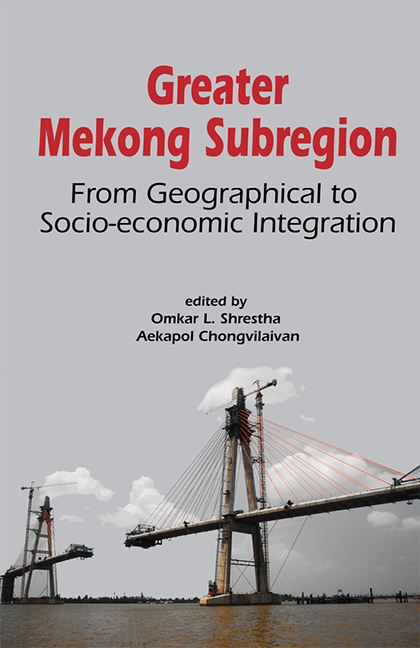Book contents
- Frontmatter
- Contents
- Preface
- List of Abbreviations
- Contributors
- 1 Greater Mekong Subregion: From Geographical Corridors to Socio-economic Corridors
- 2 Cambodia, Its Development, and Integration into the GMS: A Work in Progress
- 3 Subregional Connectivity in the Lao PDR: From Land-locked Disadvantage to Land-linked Advantage
- 4 The Economic Development of Myanmar and the Relevance of the Greater Mekong Subregion
- 5 GMS Challenges for Thailand
- 6 Deepening GMS Cooperation in a More Integrated ASEAN and East Asia
- 7 China (Yunnan)–GMS Economic Cooperation: New Development and New Problems
- 8 Trade and Investment in the Greater Mekong Subregion: Remaining Challenges and the Unfinished Policy Agenda
- 9 Enhancing Financial Cooperation among the GMS Countries
- 10 The Challenges of GMS Regional Integration: Case Study of Governance of the Logistics Industry in Thailand
- 11 Energy Sector Integration for Low-carbon Development in the GMS: Towards a Model of South-South Cooperation
- 12 Linking the Social to the Economic: Broadened Ambitions and Multiple Mitigations in New Mekong Corridors
- Index
2 - Cambodia, Its Development, and Integration into the GMS: A Work in Progress
Published online by Cambridge University Press: 21 October 2015
- Frontmatter
- Contents
- Preface
- List of Abbreviations
- Contributors
- 1 Greater Mekong Subregion: From Geographical Corridors to Socio-economic Corridors
- 2 Cambodia, Its Development, and Integration into the GMS: A Work in Progress
- 3 Subregional Connectivity in the Lao PDR: From Land-locked Disadvantage to Land-linked Advantage
- 4 The Economic Development of Myanmar and the Relevance of the Greater Mekong Subregion
- 5 GMS Challenges for Thailand
- 6 Deepening GMS Cooperation in a More Integrated ASEAN and East Asia
- 7 China (Yunnan)–GMS Economic Cooperation: New Development and New Problems
- 8 Trade and Investment in the Greater Mekong Subregion: Remaining Challenges and the Unfinished Policy Agenda
- 9 Enhancing Financial Cooperation among the GMS Countries
- 10 The Challenges of GMS Regional Integration: Case Study of Governance of the Logistics Industry in Thailand
- 11 Energy Sector Integration for Low-carbon Development in the GMS: Towards a Model of South-South Cooperation
- 12 Linking the Social to the Economic: Broadened Ambitions and Multiple Mitigations in New Mekong Corridors
- Index
Summary
Cambodia and the GMS IN Context
In international development literature Cambodia is often defined as a post-conflict, aid-dependent, least-developed country, all terms with potentially negative implications. This chapter will present a more balanced overview of Cambodia's recent development and its historical, geopolitical, and economic contexts, highlighting its achievement — until the setback of the global financial crisis and economic downturn — of high levels of economic growth, significant socio-economic development, slow but steady poverty reduction, and significant but uneven progress in state institution-building and reforms. It will also present a positive future scenario for Cambodia and the strengths and weaknesses that will determine whether this scenario can be achieved. A major factor will be Cambodia's further integration into subregional and regional economies, institutions, and strategic relationships, in the Greater Mekong Subregion, as a member of the Association of South East Asian Nations (ASEAN), and the emerging East Asian configuration of ASEAN+3, that is ASEAN, China, South Korea, and Japan or other emerging East Asia regional architecture.
Building Back From Year Zero
On 17 April 1975, soldiers of the Khmer Rouge entered the Cambodian capital, Phnom Penh. They were greeted by the local people with a mixture of relief and trepidation — relief that they might bring some prospect of an end to the civil war, and trepidation as to what this new military and ideological force might bring for Cambodia. Over the next three days the city was emptied of people. Long columns of people headed out of the city, the rationale provided to them that it was to protect the citizens of Phnom Penh from the inevitable American bombing that would follow the Khmer Rouge victory. Year Zero had begun. While the Khmer Rouge was in power, from April 1975 to January 1979, their programmes of forced labour, repression, torture, and executions, as well as disease, saw the loss of almost two million Cambodian lives, including the purging of Khmer Rouge members themselves and their leaders. Most of a generation of educated Cambodians was lost.
On 7 January 1979, the Vietnamese army, along with many Cambodians and former Khmer Rouge members who had earlier fled the Democratic Kampuchea regime, including the current Prime Minister of Cambodia, Hun Sen, invaded Cambodia, defeating the Khmer Rouge regime.
- Type
- Chapter
- Information
- Greater Mekong SubregionFrom Geographical to Socio-economic Integration, pp. 18 - 30Publisher: ISEAS–Yusof Ishak InstitutePrint publication year: 2013

